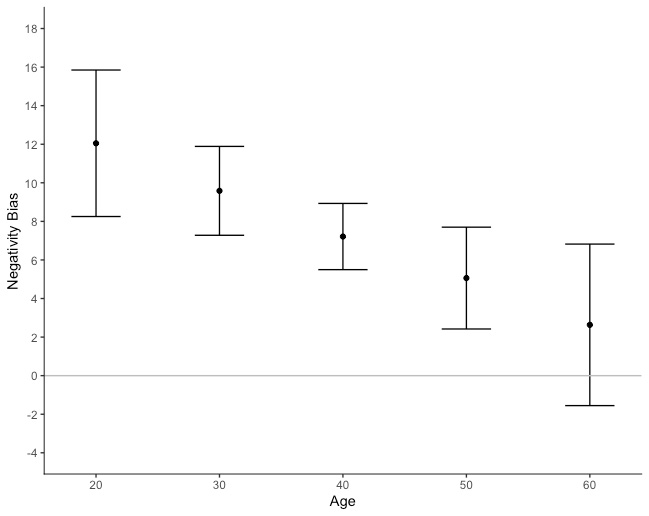We often hear messages that are communicated with a positive or negative spin. For example, a news anchor might emphasize the percentage of jobs saved from Trump’s economic plan (positive) or the percentage of jobs lost (negative). Behavioral scientists now understand that the way something is framed or described really matters: People tend to feel more positively about the same issue (such as Trump’s economic plan) when they see it framed in positive terms (jobs saved) versus negative terms (jobs lost) even though the information conveyed is the same.
My collaborators and I noticed that, in everyday life, issues are rarely framed just once—they tend to be framed and reframed in different ways over time. For example, one news anchor might emphasize the percentage of jobs saved under Trump’s plan, whereas another anchor emphasizes the percentage of jobs lost. Motivated by this real-world insight, we set out to understand what happens when frames change over time: Can people switch back and forth just as easily from positive-to-negative framing as from negative-to-positive framing, or do they tend to get stuck in one way of thinking?
In a series of experiments, we had some people rate how they felt about an issue, such as an economic plan, after seeing it framed in positive terms (that is, in terms of jobs saved) and had other people rate how they felt about the issue after seeing it framed in negative terms (in terms of jobs lost). Then, everyone saw the same issue reframed in the opposite way (positive-to-negative or negative-to-positive framing) and rated their attitudes again.
Although people’s attitudes changed along with each frame when frames switched from positive to negative, their attitudes lagged behind—or got “stuck”—when frames switched from negative to positive. That is, initial negative frames tended to “stick” or linger in people’s minds and limit how much their attitudes changed when framing became positive. People seemed to hold on to an initial negative way of thinking and not let go. Negativity biases like this one are thought to be very general human tendencies. In fact, a tendency for negative information to stick may have helped our ancestors maintain vigilance and survive threats.
In a recent project, Alison Ledgerwood and I tested whether this negativity bias in reframing may have important limits. Psychologists who study aging have found that, as people grow older, their priorities shift to focus relatively more on positives than negatives. This shift in priorities is thought to be useful: Focusing on positives can help older adults feel happy and fulfilled, which may be especially important when people don’t have many more years left. Therefore, we wondered whether the negativity bias in reframing might get smaller as people get older—and maybe even disappear or reverse into a positivity bias at an older age.
To test this idea, we reexamined the data we had collected on the negativity bias in reframing and also collected new data focusing specifically on adults between 50 and 81 years old. As previous research on age-related changes in motivational priorities would suggest, the negativity bias we observed in our previous experiments got smaller as age increased. Whereas younger adults showed a strong tendency to get stuck in negative thinking when framing switched from positive to negative, older adults were more flexible and evenhanded. In fact, by age 60, adults seem to switch just as easily from negative-to-positive framing as from positive-to-negative framing.
This graph illustrates what we found about the negativity bias. In this graph, the zero-point indicates the point at which people switch just as easily from negative-to-positive framing as from positive-to-negative framing. Each data point in this graph indicates the size of the negativity bias at a specific age in our sample of participants. As you can see, most of the data points are well above zero, indicating a general negativity bias.
But the size of the bias decreases with age. For example, the average 20-year-old who saw the negatively-framed message first changed their attitude about 12 points less when they saw the positively-framed message second compared to a 20-year-old who saw the positively-framed message first and the negatively-framed message second. This pattern suggests that at age 20, initial negative frames stick strongly and resist reframing. Yet, as the graph shows, the negativity bias gets smaller in each decade of life. And by age 60, the negativity bias has virtually disappeared.

Overall, these findings suggest that getting stuck in negative ways of thinking may be more common in younger people. As people grow older, they may find it easier to let go of the negative and reconceptualize something in positive terms. More research is needed to better understand what happens beyond age 60. Future research is aimed at answering this question and investigating other ways to help people get unstuck from negative thinking, which could have big implications for everything from how we vote to what we choose to buy.
For Further Reading
Sparks, J., & Ledgerwood, A. (2019). Age attenuates the negativity bias in reframing effects. Personality and Social Psychology Bulletin, 45, 1042–1056.
Carstensen, L. L. (2006). The influence of a sense of time on human development. Science, 312, 1913-1915.
Sparks, J., & Ledgerwood, A. (2017). When good is stickier than bad: Understanding gain/loss asymmetries in sequential framing effects. Journal of Experimental Psychology: General, 146, 1086–1105.
Jehan Sparks is a postdoctoral researcher in the Social Cognition Center Cologne at the University of Cologne, Germany. She studies how people think about positive and negative information.




